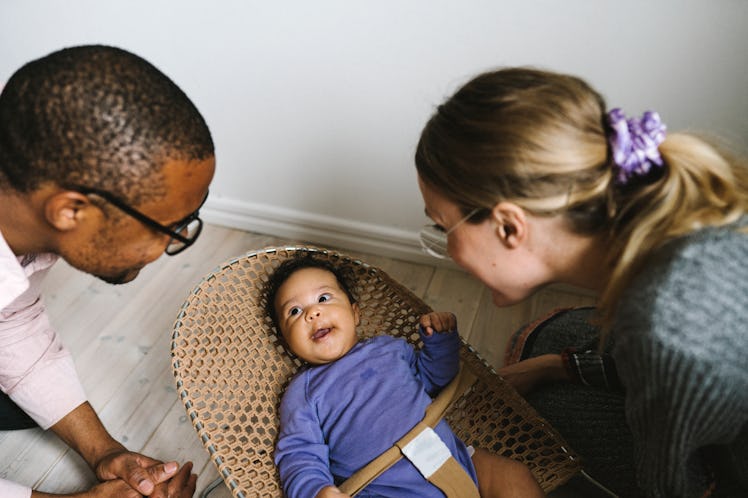How To Safely Use A Baby Swing Or Baby Bouncer
Inappropriate usage of baby swings and bouncers is widespread. Here's how to make sure your child isn't injured in an otherwise excellent accessory.

Baby bouncers and newborn baby swings are free-standing, elevated seats that let an infant sit at a semi-reclined angle. They’re basically baby pedestals that make it easier for adults and siblings to interact with the baby. They can have a calming effect too, soothing a fussy baby, or even putting them to sleep. But when these newborn swings are used incorrectly, they can be dangerous — and unsafe usage of baby bouncers is widespread.
Why Are Bouncers Bad for Babies?
It all starts with the angle. A lot of baby bouncers and swings position the infant between 30 and 45 degrees from vertical, which isn’t good for newborns. The younger babies are, the less resting muscle tone they have, which means a greater risk of their heads flopping forward and obstructing their airway. (This is why you lay your infant flat on their back when they sleep.)
The straps can also pose a problem. Entanglement is a threat pediatricians take seriously. Sleeping in a bouncer or swing simply isn’t as safe as sleeping on a firm, properly fitting mattress with minimal bedding. Still, things aren’t always cut and dry.
Can a Baby Sleep in a Swing?
“The first law of pediatrics is you don’t wake a sleeping baby,” says Ben Hoffman, M.D., a pediatrician at Oregon Health and Sciences University and chair of the American Academy of Pediatrics’ Council on Injury, Violence and Poison Prevention. “I would never advocate waking a sleeping baby, but if the baby is sleeping in a bouncy chair or a swing, somebody needs to be paying attention to them. Those are not safe ways for babies to sleep unattended.”
As long as an adult can supervise and intervene if the baby’s head flops too far forward, and ensures that the straps are snug and not in danger of compromising the baby’s breathing, the risks posed by a baby swing are minimized.
Still, it’s not a good option for feeding. “Believe it or not, gastroesophageal reflux is worse sitting at that angle than it is lying flat,” says Hoffman. “That runs counter to a lot of people’s belief, but that’s what the science tells us.”
A study by the American Academy of Pediatrics identifies falls due to baby swings and bouncers as a significant cause of ER visits for babies, either from kids squirming out on their own or from parents and caregivers dropping them as they transfer surfaces. If an infant has developed the ability to sit up on their own, or exceeds the maximum weight limit, it’s time to stop using the device.
And parents should only use a newborn swing or bouncer on the floor — not counters, not couches, not tables — and should never carry the bouncer or swing with the baby in it.
Despite the risks and necessary precautions, bouncers and swings do have benefits, as long as babies are supervised. They can be entertaining and soothing. A supervised baby in a newborn bouncer is probably better off there than napping with dad on the couch.
There’s no reason to be afraid of swings or bouncers, but every reason to be diligent.
How to Safely Use a Stand-Alone Swing or Newborn Baby Bouncer
- Always supervise a baby using a swing or a bouncer, especially if they fall asleep while using it.
- Don’t feed babies in swings or bouncers.
- Do not carry the bouncer when the baby is using it.
- Swings and newborn bouncers belong on the floor.
- Keep straps snug, but make sure they don’t restrict the baby’s airway. Think about car seat best practices.
- Don’t exceed weight limits.
- If the baby can sit up unaided, then the baby bouncer or swing is no longer safe.
This article was originally published on